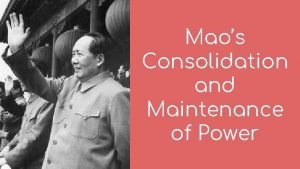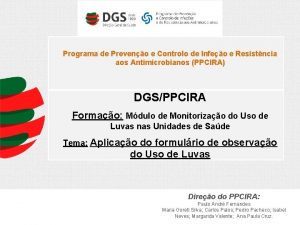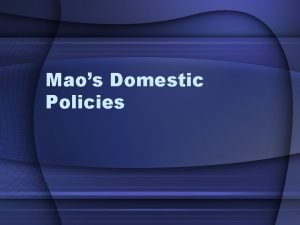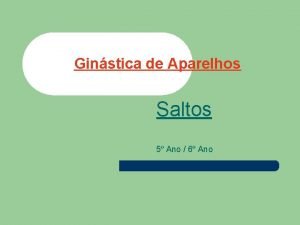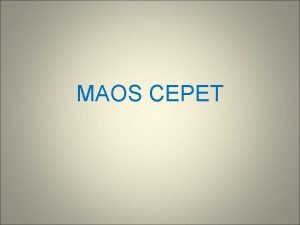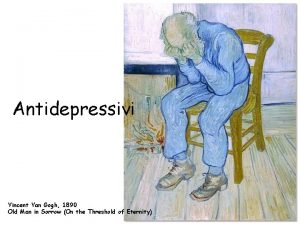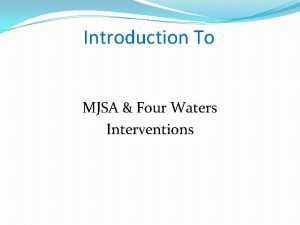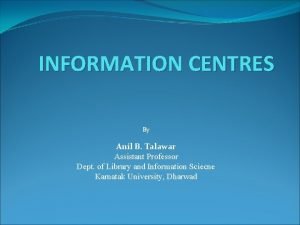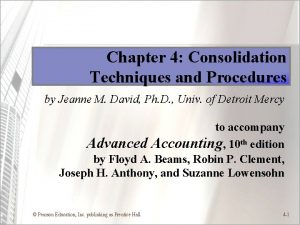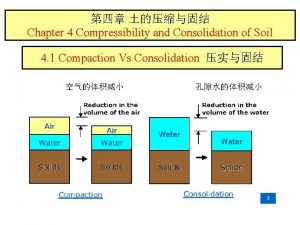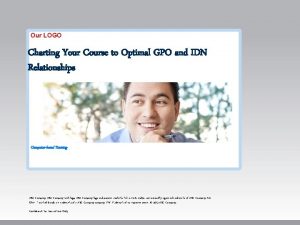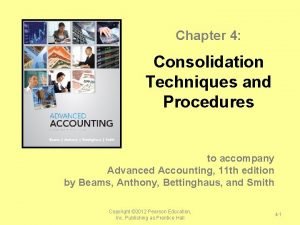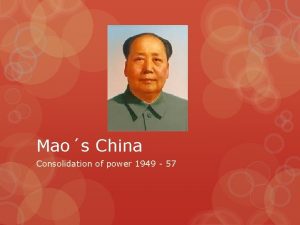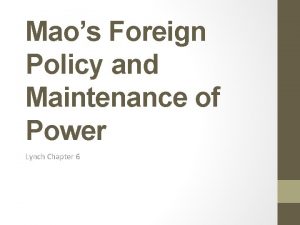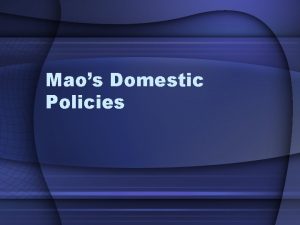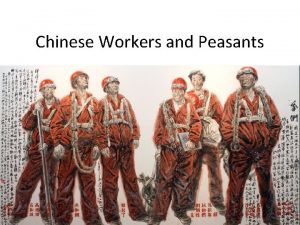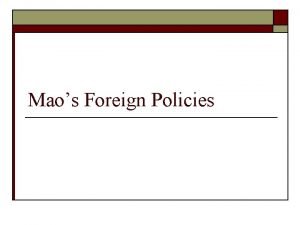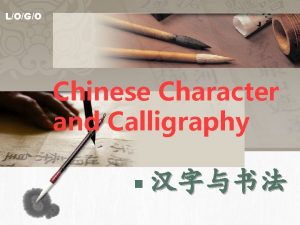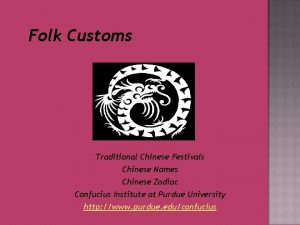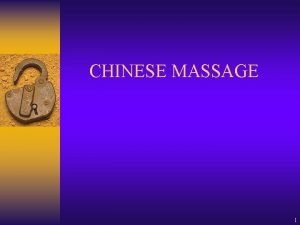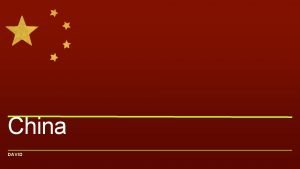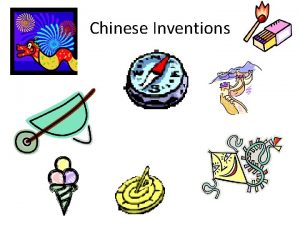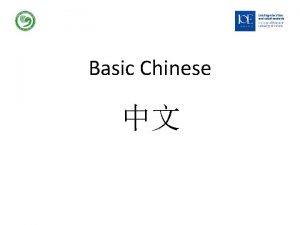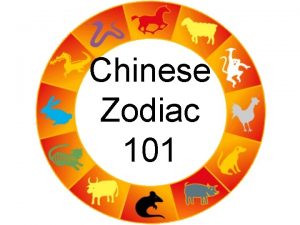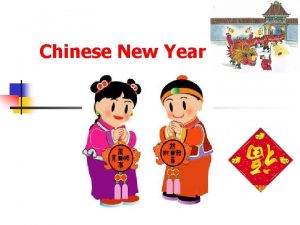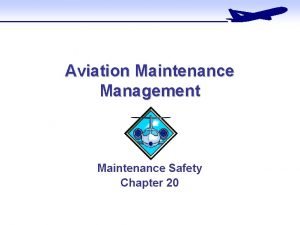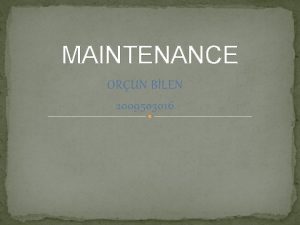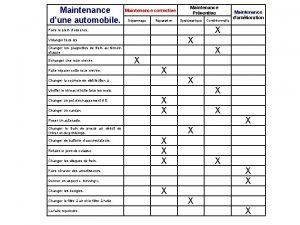Maos Consolidation and Maintenance of Power The Chinese












































![“Mao and [the CCP] believed their reconstruction of a new socialist China depended on “Mao and [the CCP] believed their reconstruction of a new socialist China depended on](https://slidetodoc.com/presentation_image_h/15673ce4ee056853f790b35d6980d29d/image-45.jpg)




- Slides: 49

Mao’s Consolidation and Maintenance of Power

The Chinese Communist Party

The Chinese Communist Party (CCP) During this initial period, the CCP made great strides toward bringing the country through three critical transitions: ★ economic prostration ★ political disintegration ★ military rule economic growth political strength civilian rule. The determination and capabilities demonstrated during these first years and the respectable showing (after a century of military humiliations) that Chinese troops made in 1950– 53 provided the CCP with a reservoir of popular support that would be a major political resource for years.

The CCP (cont. ) “Despite the coercive society that Mao’s China was in practice, in theory it was one of the freest in the world. ” -Lynch ★ The Communist Party claimed that all power rested with the people and that the party officials and the government acted as servants of the nation. ★ The reality in the PRC was that the Communist Party, not the people, ruled ★ The government was carried by the Politburo , which was under the authority of Mao ★ The National People’s Congress never challenged, let alone reversed, party policy on any issue that mattered. ★ There was little chance of anyone critical of Mao or the government ever being successful in elections

Economic Policies

National Capitalism National/State Capitalism: an economic system in which private capitalism is modified by a varying degree of government ownership and control ★ The CCP wanted to reform state capitalism while preserving the fundamental institutional pillars of state capitalism ★ The ultimate goal was to move towards Capitalism, but Mao realized that this would take a long time

“Mao announced that the PRC was ready to use the resources of ‘the national capitalists ’ to begin the reconstruction of China under Communism. ” -Michael Lynch

The First Five Year Plan 1952: China’s first Five-Year Plan was introduced. Its aim was to develop the state-directed growth of heavy industry. Inflation was dropped from 1000% in 1949 to only 15% in 1952 by: ★ Slashing public expenditure ★ Raising tax rates on urban dwellers ★ Replacing the old Chinese dollar with a new currency, known as the renminbi or yuan.

The First Five Year Plan (cont. ) Areas targeted for increased production were: ★ Coal ★ Steel ★ Petrochemicals. There was also development of a Chinese automobile and transport industry. As a morale-boost a number of spectacular civil-engineering projects were undertaken. Ex: The construction of a vast road and rail bridge across the Yangzi River at Nanjing.

The Anti-Campaigns AKA The Anti-Movements

The Three Anti-Campaign 1951: Mao announced the beginning of the Three Anti-Campaign the targets being: ★ waste ★ corruption ★ inefficiency

“The Three Anti-Campaign was intended to be a mass movement which would stimulate and mobilize the entire population to attack” and “excite public emotions for use… against merchants and industrialists” -Theodore Hsi-En Chen and Wen-Hui C. Chen *we will return to the topic of mass mobilization later

The Five Anti-Campaign 1952: Mao expanded the Three Anti. Campaign into the Five Anti-Campaign This was meant to stimulate the economy by attacking: ★ ★ ★ Industrial sabotage Tax evasion Bribery Fraud Theft of government property

The expansion to the Five Anti-Campaign was to “extend the program beyond government circles… with the aim of reaching business people throughout the country. ” “The Five Anti-Campaign was termed by the Communist leaders a ‘counter-offensive to repel the ferocious attacks of the bourgeoisie’. ” -Theodore Hsi-En Chen and Wen-Hui C. Chen The 'Three-Anti' and 'Five-Anti' Movements in Communist China

The Anti-Campaigns were aimed at: ★ Members of the Communist party who had become too close to the capitalists ★ Former Kuomintang members ★ Bureaucratic officials who were not party members ^What Mao defined as ‘the bureaucratic capitalist class’. ★ The Five Anti-Campaign was aimed at the Capitalists themselves

“Confession road” “Frankly, there is a way out” “Only by confessing is there a way out. ”

“It was clear that 3 years after the Communist takeover Mao felt able to turn openly against the classes which he had been obliged to tolerate earlier” -Michael Lynch

The Hundred Flowers Campaign

The Hundred Flowers Campaign 1956 or 1957 May 1956: A movement begun within the Communist government to lift the restrictions imposed on Chinese intellectuals ★ Encouraged greater freedom of thought and speech It was inspired by the relaxation of strict communist controls in the Soviet Union in February 1956 after the death of Stalin

Mao invited criticism of the Chinese Communist Party’s policies (even by noncommunist intellectuals) with a famous slogan from Chinese classical history: “Let a hundred flowers bloom, and a hundred schools of thought contend. ”

“Deeply criticize Deng Xiaoping’s counterattack against the right. ”

As a result of Nikita Khrushchev’s de-Stalinization, “Khrushchev denounced Stalin for his ‘cult of personality ’. Mao could see how easily this charge could be made against himself in China. His apparent encouragement of criticism from within the party was, therefore, a way of taking the sting out of such a suggestion and preventing the comparison being made between him and Stalin. ” -Michael Lynch

The Hundred Flowers Campaign 1956 (cont. ) ★ The criticisms were slow to commence, out of fear ★ But by Spring of 1956, members of the party began to openly criticize Communist individuals and policies openly - Including criticism of Mao himself ★ Within a few weeks the party became subjected to an everincreasing volume of criticism ★ By June of 1956, the Communist party began to signal that the criticism had gone too far and The Hundred Flowers Campaign was replaced with the Anti-Rightist Campaign

The Anti-Rightist Campaign

The Anti-Rightist Campaign July 1956 or 1957 July 1956: During the Anti-Rightist Campaign, the recent critics of the Communist regime were subjected to severe punishment ★ Most of them lost their jobs and were forced to do manual labour in the country while others were sent to prison “It became a time not of freedom of expression, but of fierce repression. ” -Lynch

“This campaign led to the persecution of several hundreds of thousands of people from all social strata, including many intellectuals who, after much hesitation, had made statements, at the insistent demand of authorities, as part of the Party rectification campaign imposed by Mao Zedong” -Christine Vidal The 1957 -1958 Anti-Rightist Campaign in China: History and Memory (19782014)

The Anti-Rightist Campaign (cont. ) ★ People were forced to retract their statements or were obliged to make abject confessions and submit themselves to ‘re-education’ ★ The party was purged of those who were too free with their objections and criticisms ★ Zhou Enlai, despite being one of Mao’s most loyal supporters, was obliged to make a humiliating self-criticism in front of a large party gathering “Nobody was safe. The only way to avoid suspicion, therefore, was to conform absolutely to Mao’s wishes. ” -Lynch

Historians Debate: What were Mao’s motives in launching The Hundred Flowers Campaign? Chinese-British historian Jung Chang: ★ Argues that the campaign was a trick on Mao’s part to bring his critics out into the open U. S scholar Lee Feigon: ★ Argues that Mao’s original intentions were genuine and that his aim was to have the people undermine the bureaucrats British-American historian Jonathan Spence: ★ Sees the affair as the confused result of contradictory thinking among the CCP leaders:

Historians Debate: What were Mao’s motives in launching The Hundred Flowers Campaign? Further points: ★ Regardless of Mao’s motives, it was the scale of the criticism that The Hundred Flowers Campaign unleashed that took him aback ★ If Mao had launched the campaign out of fear of being compared to Stalin, this fear would have greatly lessened by late 1956

The Use of Force and Terror

Political ‘Purges’ ★ In 1949, at the beginning of the Communists ruling, there had been over 10 separate political parties in China. ★ By 1952 they had all disappeared

The other political parties were “destroyed in a set of repressive moves which denied the right of any party to exist other than the Chinese Communist Party. The political purges were accompanied by a series of mass campaigns aimed at extending the CCP’s authority over the people of China. ” -Michael Lynch

Mass Killings In Shanghai and Guangzhou, the CCP had previously used the underworld gangs and branches of organized crime during the years of Nationalist rule to consolidate their hold on the cities In the early 1950 s, once the CCP had come into power, they turned on them in a “violent bloodletting” (Lynch) ★ Over half of the 130, 000 ‘bandits and criminals’ rounded up in Guangzhou were executed ★ Similarly, the death toll in Shanghai was around 28, 000

Terror Tactics To maintain its control, the CCP turned China into a nation of informers. Local party officials created a system in which: Neighbours spied on neighbours Workers reported on their friends Children reported on their parents Each street or tenement block had officially appointed ‘watchers’ who kept the local CCP informed on anyone or anything suspicious ★ Community associations, which were set with the declared aim of providing mutual help, became a major means of exerting control and conformity. ★ ★

Land Policies ★ The property of landlords was confiscated and redistributed among their former tenants ★ Some were allowed to keep a portion of their land provided they became peasants ★ However, the majority of landlords were put on public trial and denounced as enemies of the people Evidence suggests that about a million landlords were killed during these land reforms

Registration There were three main types of registration: ★ danwei – a permit without which an individual could not hold a job ★ hukou – a certificate which entitled a family to obtain accommodation ★ dangan – a dossier held by local party officials containing the personal details and record of every individual.

“The dangans became the chief means by which the authorities maintained political and social control over the Chinese people. A person’s right to employment, housing or a pension, or indeed to his freedom, depended on the contents of his dossier. ” -Michael Lynch

Thought Control “In the People’s Republic there was to be no toleration of independent thinking, let alone dissent. ” -Lynch ★ youth organisations were either closed down or taken over by party cadres ★ Religion was selected for special attack China was on its way to become a society of informers. Conformity was maintained by exploiting the traditional fear of the Chinese people - of being publicly exposed as political or social deviants.

Mass Movements and the ‘Divide and Rule’ Strategy

★ One highly significant aspect of the Anti-Campaigns had to do with inciting and organizing the masses for action, termed ‘mass mobilization’. “In ‘mobilizing’ mass emotions and action against the bourgeoisie, the Communists sought to achieve not only their immediate purpose of turning the "wrath of the people" against the "treacherous merchants" and politically suspect bourgeoisie, but also their long-range program of "educating" the masses by involving them actively in the ‘bitter class struggle’. ” (Chen) ^This is an example of the ‘Divide and Rule’ strategy

The ‘Divide and Rule’ Strategy Divide and Rule: The policy of maintaining control over one's subordinates or subjects by encouraging dissent between them. ★ By turning the Chinese people against one another, Mao is able to control them

In a public statement about the Anti-Campaigns in 1952, Mao said: Our present task is to strengthen the people’s state apparatus – meaning principally the people’s army, the people’s police and the people’s courts – thereby safeguarding national defence and protecting the people’s interests. We definitely have no benevolent policies towards the reactionaries or the counter-revolutionary activities of the reactionary classes. Our benevolent policy does not apply to such deeds or such persons, who are outside the ranks of the people; it applies only to the people.

★ One way to mobilize the masses was to work through mass organizations i. e women's federations, youth organizations These work as “sounding boards” for the voice of the government or Party. Declarations made are “echo[ed] by the mass organizations as they ‘call on their [members] to support the official policy’. ” Moreover, “Their unanimity creates an appearance of wide popular support” (Chen).

“These mass organizations are the tentacles which enable the government and Party to extend their control to the various groups and levels of the population. ” -Theodore Hsi-En Chen and Wen-Hui C. Chen
![Mao and the CCP believed their reconstruction of a new socialist China depended on “Mao and [the CCP] believed their reconstruction of a new socialist China depended on](https://slidetodoc.com/presentation_image_h/15673ce4ee056853f790b35d6980d29d/image-45.jpg)
“Mao and [the CCP] believed their reconstruction of a new socialist China depended on the mass line and the frequent mass mobilization campaigns were the techniques necessary to ensure Mao's continuing revolution. ” People were convinced to participate by Mao’s promises of a new China “through the removal of those undesirable deviants” and were motivated by “the opportunity of working under [Mao] for the building [of] a new China” -Wen-hui Tsai Mass Mobilization Campaigns in Mao's China

Compare/Contrast: Consolidation of Power Stalin & Mao

Similarities- Economic Policies Both Stalin and Mao: ★ Had Five Year Plans (of which Mao’s was inspired by Stalin’s) ★ Made changes to the existing economic structures as a way of moving towards communism The similarities here are likely due to the fact that Mao was actively attempting to copy the successes of the Soviet Union

Similarities- The Use of Force and Terror Both Stalin and Mao: ★ Successfully ‘purged’ their political enemies ○ Including publicly humiliating and executing them ★ Used violence against the people, killing millions ○ Both targeted the bourgeoisie ★ Had their citizens spy on each other ○ creating “a nation of informers” (Lynch)

Differences ★ After the death of Stalin, Mao wanted to separate himself from Stalin, as he did not want something similar to ‘de. Stalinization’ to occur in China ^This can be considered a success as Mao remains highly regarded in China, while Stalin is no longer widely admired in Russia ★ Mao took a much more rigid approach on keeping documents on each individual in society
 Mao consolidation and maintenance of power
Mao consolidation and maintenance of power Primary 3 malay worksheets
Primary 3 malay worksheets Ac power formula
Ac power formula Formulário de observação higiene das mãos dgs
Formulário de observação higiene das mãos dgs Fear be conquered
Fear be conquered Salto de eixo no plinto
Salto de eixo no plinto Identifique qual das alternativas trata-se de metáfora
Identifique qual das alternativas trata-se de metáfora Receba senhor por tuas mãos este sacrificio
Receba senhor por tuas mãos este sacrificio Acolhei as oferendas deste vinho e deste pão
Acolhei as oferendas deste vinho e deste pão Nao tenhas nada nas maos
Nao tenhas nada nas maos Adestrou
Adestrou Das alturas orvalhem os céus
Das alturas orvalhem os céus Sim senhor nossas mãos vão plantar o teu reino
Sim senhor nossas mãos vão plantar o teu reino Canto de ofertório de mãos estendidas
Canto de ofertório de mãos estendidas Maca endah yaiku
Maca endah yaiku Goghle maos
Goghle maos Rolamento engrupado
Rolamento engrupado Preventive and predictive maintenance of hydro power plant
Preventive and predictive maintenance of hydro power plant Merger and acquisition
Merger and acquisition Compaction and consolidation difference
Compaction and consolidation difference Examples of information centres
Examples of information centres Consolidation techniques and procedures
Consolidation techniques and procedures What is merger and consolidation
What is merger and consolidation Stock spotting warehousing
Stock spotting warehousing Iot conceptual and architectural framework,
Iot conceptual and architectural framework, Coefficient of volume compressibility
Coefficient of volume compressibility Idn vs gpo
Idn vs gpo Consolidation techniques and procedures
Consolidation techniques and procedures Hình ảnh bộ gõ cơ thể búng tay
Hình ảnh bộ gõ cơ thể búng tay Bổ thể
Bổ thể Tỉ lệ cơ thể trẻ em
Tỉ lệ cơ thể trẻ em Gấu đi như thế nào
Gấu đi như thế nào Glasgow thang điểm
Glasgow thang điểm Alleluia hat len nguoi oi
Alleluia hat len nguoi oi Các môn thể thao bắt đầu bằng tiếng đua
Các môn thể thao bắt đầu bằng tiếng đua Thế nào là hệ số cao nhất
Thế nào là hệ số cao nhất Các châu lục và đại dương trên thế giới
Các châu lục và đại dương trên thế giới Cong thức tính động năng
Cong thức tính động năng Trời xanh đây là của chúng ta thể thơ
Trời xanh đây là của chúng ta thể thơ Cách giải mật thư tọa độ
Cách giải mật thư tọa độ 101012 bằng
101012 bằng độ dài liên kết
độ dài liên kết Các châu lục và đại dương trên thế giới
Các châu lục và đại dương trên thế giới Thơ thất ngôn tứ tuyệt đường luật
Thơ thất ngôn tứ tuyệt đường luật Quá trình desamine hóa có thể tạo ra
Quá trình desamine hóa có thể tạo ra Một số thể thơ truyền thống
Một số thể thơ truyền thống Cái miệng nó xinh thế chỉ nói điều hay thôi
Cái miệng nó xinh thế chỉ nói điều hay thôi Vẽ hình chiếu vuông góc của vật thể sau
Vẽ hình chiếu vuông góc của vật thể sau Thế nào là sự mỏi cơ
Thế nào là sự mỏi cơ
